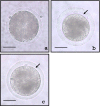Sericin accelerates the production of hyaluronan and decreases the incidence of polyspermy fertilization in bovine oocytes during in vitro maturation
- PMID: 24748396
- PMCID: PMC4139500
- DOI: 10.1262/jrd.2013-110
Sericin accelerates the production of hyaluronan and decreases the incidence of polyspermy fertilization in bovine oocytes during in vitro maturation
Abstract
Fetal bovine serum (FBS) has been widely used as a supplement in the maturation medium of bovine oocytes in vitro. However, serum contains many undefined factors and is potentially infectious to humans and animals. As a serum replacement, we evaluated the feasibility of using the silk protein, sericin, derived from the cocoons of silkworm. To examine the rates of oocyte maturation and fertilization, cumulus-oocyte complexes were cultured in TCM-199 supplemented with 0.01%, 0.05%, 0.1% or 0.15% sericin or 5% FBS. The sizes of the perivitelline space that might relate to polyspermy, the expressions of Has2 and CD44 mRNA, the amount of hyaluronan (hyaluronic acid: HA) contained in the oocytes and the rates of blastocyst formation following insemination were then compared between the oocytes cultured with 0.05% sericin and 5% FBS, because the polyspermy rates in oocytes cultured with 0.05% sericin were significantly lower than in those cultured with 5% FBS. After in vitro maturation (IVM), the mean size of the perivitelline space was significantly greater in oocytes cultured with sericin than in those cultured with FBS, although the rates of nuclear maturation, fertilization and blastocyst formation of oocytes under both IVM conditions were not significantly different. The expression of HAS2 and CD44 mRNA and the amount of HA in the denuded oocytes cultured with 0.05% sericin were significantly greater than in those cultured with FBS. These results indicate the feasibility of sericin as an alternative protein supplement for IVM in bovine oocytes.
Figures


Similar articles
-
Effect of sericin supplementation during in vitro maturation on the maturation, fertilization and development of porcine oocytes.Reprod Domest Anim. 2014 Apr;49(2):e17-20. doi: 10.1111/rda.12274. Epub 2014 Jan 28. Reprod Domest Anim. 2014. PMID: 24467637
-
Combined epidermal growth factor and hyaluronic acid supplementation of in vitro maturation medium and its impact on bovine oocyte proteome and competence.Theriogenology. 2015 Mar 15;83(5):874-80. doi: 10.1016/j.theriogenology.2014.11.022. Epub 2014 Nov 26. Theriogenology. 2015. PMID: 25497783
-
Replacement of serum with sericin in in vitro maturation and culture media: Effects on embryonic developmental competence of Sanjabi sheep embryo during breeding season.Theriogenology. 2017 Apr 1;92:144-148. doi: 10.1016/j.theriogenology.2016.12.027. Epub 2016 Dec 24. Theriogenology. 2017. PMID: 28237330
-
Morphological and biochemical dynamics of porcine cumulus-oocyte complexes: role of cumulus expansion in oocyte maturation.Ital J Anat Embryol. 2005;110(2 Suppl 1):205-17. Ital J Anat Embryol. 2005. PMID: 16101040 Review.
-
Proteomes of animal oocytes: what can we learn for human oocytes in the in vitro fertilization programme?Biomed Res Int. 2014;2014:856907. doi: 10.1155/2014/856907. Epub 2014 Apr 3. Biomed Res Int. 2014. PMID: 24804254 Free PMC article. Review.
Cited by
-
The effects of sericin on cryopreserved sperm cells and subsequent embryo development in mice.Int J Reprod Biomed. 2018 Jun;16(6):405-412. Int J Reprod Biomed. 2018. PMID: 30123869 Free PMC article.
-
The effects of supplemented sericin on in vitro maturation and preimplantation development of mouse embryos: An experimental study.Int J Reprod Biomed. 2021 Nov 4;19(10):921-928. doi: 10.18502/ijrm.v19i10.9824. eCollection 2021 Oct. Int J Reprod Biomed. 2021. PMID: 34805732 Free PMC article.
References
-
- Abe H, Hoshi H. Evaluation of bovine embryos produced in high performance serum-free media. J Reprod Dev 2003; 49: 193–202 - PubMed
-
- Korhonen K, Kananen K, Ketoja E, Matomäki J, Halmekytö M, Peippo J. Effects of serum-free in vitro maturation of bovine oocytes on subsequent embryo development and cell allocation in two developmental stages of day 7 blastocysts. Reprod Domest Anim 2010; 45: 42–49 - PubMed
-
- Abe H, Yamashita S, Satoh T, Hoshi H. Accumulation of cytoplasmic lipid droplets in bovine embryos and cryotolerance of embryos developed in different culture systems using serum-free or serum-containing media. Mol Reprod Dev 2002; 61: 57–66 - PubMed
-
- Rizos D, Gutiérrez-Adán A, Pérez-Garnelo S, De La Fuente J, Boland MP, Lonergan P. Bovine embryo culture in the presence or absence of serum: implications for blastocyst development, cryotolerance, and messenger RNA expression. Biol Reprod 2003; 68: 236–243 - PubMed
-
- Abe H, Yamashita S, Itoh T, Satoh T, Hoshi H. Ultrastructure of bovine embryos developed from in vitro-matured and -fertilized oocytes: comparative morphological evaluation of embryos cultured either in serum-free medium or in serum-supplemented medium. Mol Reprod Dev 1999; 53: 325–335 - PubMed
Publication types
MeSH terms
Substances
LinkOut - more resources
Full Text Sources
Other Literature Sources
Research Materials
Miscellaneous

